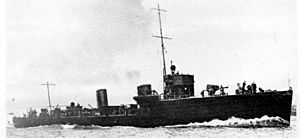HMS Ardent (1913) facts for kids

Ardent
|
|
Quick facts for kids History |
|
|---|---|
| Name | Ardent |
| Builder | William Denny & Brothers, Dumbarton |
| Laid down | 9 October 1912 |
| Launched | 8 September 1913 |
| Commissioned | February 1914 |
| Fate | Sunk at Battle of Jutland, 1 June 1916 |
| General characteristics (as built) | |
| Class and type | Acasta-class destroyer |
| Displacement | 1,072 long tons (1,089 t) (deep load) |
| Length | 267 ft 6 in (81.5 m) |
| Beam | 27 ft (8.2 m) |
| Draught | 9 ft 6 in (2.9 m) |
| Installed power | |
| Propulsion | 2 shafts; 1 steam turbine |
| Speed | 29 knots (54 km/h; 33 mph) |
| Range | 1,540 nmi (2,850 km; 1,770 mi) at 15 knots (28 km/h; 17 mph) |
| Complement | 73 |
| Armament |
|
HMS Ardent was a type of warship called a destroyer. It was one of 20 such ships built for the Royal Navy in the 1910s. Ardent was finished in 1914. It served in the First World War and was sunk during the Battle of Jutland in 1916.
Contents
What Was the Acasta-Class Design?
The Acasta class of destroyers was based on an earlier, very fast ship called HMS Firedrake. Ardent was special because it used a new way of building ships. This method, called longitudinal framing, made the ship's body, or hull, stronger. It was also lighter than older building methods.
Ardent was 267 feet 6 inches (82 m) long. This is about the length of two basketball courts! It was 27 feet (8.2 m) wide. The ship sat 9 feet 6 inches (2.9 m) deep in the water. When fully loaded, it weighed about 1,072 long tons (1,089 t). A crew of 73 sailors worked on board.
How Fast Was Ardent?
The destroyers were powered by a steam turbine engine. This engine turned two propeller shafts. Steam came from three large Yarrow boilers. Ardent had three boilers, which was different from its sister ships that had four. It also had two funnels instead of four.
The engines produced a lot of power, about 24,500 shaft horsepower (18,300 kW). This power was designed to make the ship go 29 knots (54 km/h; 33 mph). During its sea trials, Ardent actually reached a speed of 29.5 knots (54.6 km/h; 33.9 mph). The Acasta-class ships could travel 1,540 nautical miles (2,850 km; 1,770 mi) at a slower speed of 15 knots (28 km/h; 17 mph).
What Weapons Did Ardent Have?
The main weapons on Ardent were three 4-inch (102 mm) guns. These guns were placed on single mounts. One gun was at the front of the ship. Another was between the funnels. The third gun was at the back.
The destroyers also had two torpedo tubes. These tubes could fire large 21-inch (533 mm) torpedoes. They were located in the middle of the ship. Ardent also carried two extra torpedoes to reload.
Ardent's Service and Fate
HMS Ardent was the seventh ship in the Royal Navy to have this name. It was ordered in 1911 and built by William Denny & Brothers. The ship's construction started on 9 October 1911. It was launched into the water on 8 September 1912. Ardent was officially ready for service in February 1914.
After it was finished, Ardent joined the 4th Destroyer Flotilla. It served with the main British fleet, called the Grand Fleet, when the First World War began.
Ardent was sunk on 1 June 1916. This happened during the Battle of Jutland. A German battleship named SMS Westfalen fired at Ardent. Seventy-eight sailors went down with the ship. Only two people survived.
Today, the place where Ardent sank is a special protected area. It is protected under the Protection of Military Remains Act 1986. This means the wreck is a historical site and should not be disturbed.

